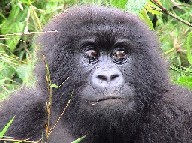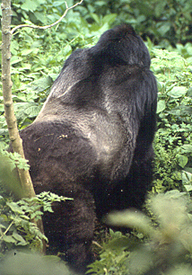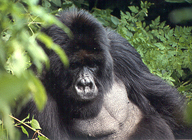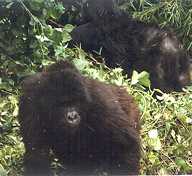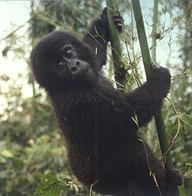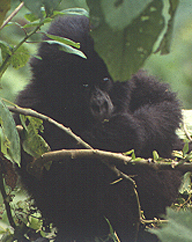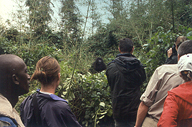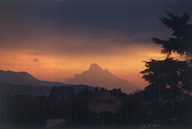“I get the feeling its like looking for a needle in a haystack.” Staring into the submarine darkness of the rainforest I could not help but agree with Rachael that there was little chance of us finding the needle by ourselves. But the needle we were looking for was no ordinary needle and thus we had a retinue of trackers and guides to help us in our search.
We were searching for the endangered mountain gorilla in the Bwindi Impenetrable Forest in Uganda, one of only two places on earth now inhabited by the great ape. Gorillas once inhabited a great swathe of rainforest that stretched from the coast of West Africa to the western arm of the Great Rift Valley but when the climate dried out during the ice ages, the extensive forests receded into pockets and as a result gorillas became divided into western and eastern populations. Over time the genetic drift led to the development of the three subspecies, the western lowland gorilla, the eastern lowland gorilla and the mountain gorilla.
The mountain gorilla is the rarest of all the apes and is only to be found in two small populations, each numbering approximately three hundred. One population is in Bwindi, where we were, the other in the Virunga Volcanoes, which were carved up by the colonial powers to be part of Rwanda, Congo and Uganda. Although gorillas have long been known to Africans, for centuries they were mysterious and unknown to the rest of the world and were not discovered scientifically until two animals were shot on the slopes of Mt Sabinyo in 1902. The unfortunate gorillas were shot by a German army officer Oscar von Beringe whose name has ironically been attached to the subspecies, gorilla gorilla beringei.
This year, 2002, is the centenary of Beringe’s ‘scientific’ discovery but thankfully the trophy bagging of the early twentieth century now takes a different form: the gun has been replaced by the camera and the hunter by the tourist. Tourism and the money that it brings in – each permit to track the gorillas for one day costs US$250 – appears to have had a positive effect on the mountain gorillas’ fate. Tourism has helped to pay Park Rangers’ salaries to hunt poachers and has helped to put pressure on the Ugandan and Rwandan governments to gazette the areas as National Parks. Furthermore the increased number of visitors to the Parks has made it more difficult for the poachers to wander undetected throughout the Virungas and Bwindi. Tourism has thus become integral to the survival of the mountain gorilla.
To visit the awesome mountain gorilla we flew to the lush central African countries of Rwanda and Uganda. The next morning we set off from Kampala, Uganda’s capital, to Bwindi in the south-west of the country, a long dusty drive that was relieved only by a quick stop to buy fruit at a roadside stall and then for lunch where the snacks were advertised as being ‘fastly prepared’. I am not sure if this was my first taste of Ugandan sense of humour or if I had not yet adjusted from my time obsessed western lifestyle to the more laid back African pace of life, but there was little evidence of speed over lunch.
In fact lack of speed was to blight our progress all day and we arrived at Bwindi at night and were forced to scramble around in the dark oblivious to our surrounds (there is no electricity in Bwindi and generators are forbidden as they would disturb the gorillas and the other wildlife of the forest). Thus it was not until I was awoken in the early morning by the low resonant call of the colobus monkey and looked out of my tent did I appreciate the true beauty of the camp’s setting. The morning mist blanketing the rainforest. I was thrilled to be in the midst of the domain of the gorilla.
After a hearty breakfast to sustain us for the rigours of the tracking that lay ahead, it was a short walk to the Park Ranger’s Headquarters where we registered and met the other tourists fortunate enough to have permits to go tracking for that day. In Bwindi there are only two gorilla groups, Mubare and Habinyanjo, that have been habituated and can be visited by tourists and to keep behavioural disturbance, stress and the risk of infection to these gorillas to a minimum, only six visitors a day may visit each family and only for an hour at a time. Thus there are only twelve permits available for gorilla tracking on any day in Bwindi and advance booking is essential if you are to avoid disappointment.
Levy, our guide for the day, delivered a comprehensive briefing about various do’s and don’ts to be observed when with the gorillas. We were told not to stand up higher than the gorillas. They don’t like it. We were told not to point at the gorillas. They don’t like that either. Most importantly we were told that if we were unwell we should not visit the gorillas – the danger of contracting human illnesses or diseases is one of the biggest threats to the gorillas. We were also told that we should always try and remain at least five metres away from the great apes, for the gorilla’s safety rather than our own, as the distance would help to reduce the risk of transmission of disease.
Briefing finished, we headed off into the undergrowth escorted by several soldiers, who were there to protect us from guerrillas rather than the gorillas. Some of our group were a little unsettled by their presence, seeing it as a sad reminder of the region’s unsettled past. I chose to see our armed guard as a mark of how much the Ugandan government valued tourism and the much-need revenue that it brings to the region. Despite the presence of soldiers and the negative FCO travel advice against much of the region, at no point whilst I was in Uganda or Rwanda did I feel unsafe or threatened.
The trackers went ahead to pinpoint exactly where the gorillas had slept, for as Levy explained with graphic frankness gorillas never sleep in the same twice because “they shit in their beds”. I was also interested to learn that the smaller, lightweight gorillas nested in trees, making beds of bent branches, whereas the heavier individuals nested in grasses on the ground with babies snuggling up against their mothers. Once the nests had been located the tracking began in earnest.
Thankfully for unfit tourists such as myself, gorillas do not move great distances, moving only about one kilometre each day (they do however move much greater distances if they have been disturbed or are stressed). In fact gorillas spend about thirty per cent of their time feeding, forty per cent of the day at rest and the remaining thirty per cent of their time foraging and moving. Though we did not have to travel far, the terrain that we were moving over was far from easy - the name of the park, Bwindi Impenetrable Forest, was not a marketing or advertising gimmick to lend a feel of adventure to the experience but a reality. The terrain was steep, the undergrowth thick and we were continually climbing under, over, around fallen trees and loosing our footing on the slippery slopes.
After about an hour and a half of stumbling over vines and continually being stung by nettles we suddenly stopped. Levy’s eyes darted back and forth, up and down. He turned to us and whispered that the gorillas were close by. My heartbeat raced in excitement and anticipation. As we inched forward Levy and the trackers began to emit a low rumbling cough to alert the gorillas to our presence – I am sure this was done more for our benefit than for that of the gorillas whom must surely have heard us noisily crashing through the undergrowth.
I heard and smelt them long before I saw them. A warning bark sent shivers of excitement down by spine and shortly after that I caught a whiff of a strong pungent odour of garlic and onions. We crept forward, adrenalin pumping, and then froze as a tracker pointed up at a tree a few metres away. A beautifully furry juvenile was swinging back and forth in the branches. It was a surreal moment and it was difficult to grasp that the furry ball in front of me was a gorilla let alone describe my feelings.
We didn’t see the entire group immediately. A bit of manoeuvring was required to get a better view of the group and we had to scramble down the slope lowering ourselves down with vines. Once on slightly flatter ground I found myself surrounded by over a dozen gorillas. They were close, no, they were very, very close yet amazingly unperturbed by our presence.
I found it difficult to get over how gentle the gorillas were, how untroubled they were by the clicking of our cameras. King Kong and Hollywood’s portrayal of the gorilla as ferocious man-like beast could hardly have been further from the truth. For years the popular imagination has been stimulated by greatly exaggerated descriptions of gorillas that bore little relation to the actual animal and it was not until 1959 when George Schaller first began to study gorillas in the Virunga volcanoes that their true nature as a shy, gentle, peace-loving vegetarians was revealed to the world.
Laid back and unconcerned the group continued to munch on vegetation, stuffing a handful of leaves into their mouths at a time. They calmly and unhurriedly continued to feed and play all around us. A mother showed tremendous patience with her bubbling-with-energy baby who loved to do tumbling acts on her stomach. It was truly magical
Gorillas are the largest of the great apes, the group that includes chimpanzees and orang-utans, and contain 97% of the genetic make-up of humans – a paper statistic that is meaningless until you come face to face with these gentle giants. Similarities in the physiology of humans and apes are striking but more fascinating are the similarities in social behaviour, intellectual behaviour and expression of emotions. They express emotions similar to those we call joy and sadness, fear and despair. They can suffer mentally as well as physically. They are so like us.
I watched and became engrossed in their tiniest movements. Ruhondeza would nonchalantly turn his head and look at us over his left shoulder and then dismissively resume his chewing. Kashondwe, an adult female, lying on her back would lazily scratch her side in a slow unhurried circular motion as if for pleasure. Kahara, a sub-adult female, scratched her head quickly in annoyance. Her fingers were fat and long with pointed nails almost like an old hag or witch from a fairy tale. A juvenile beat his chest in imitation of his father whilst another thumped the ground in mock irritation. It is easy to anthropomorphise their actions but they were remarkably similar to ours.
It was the sheer size of Ruhondeza, the silverback, that was most arresting. Although large, weighing up to 200 kg and roughly two and a half times the size of the average man, it was the size of his skull and hands that most impressed me. It was humbling and yet at the same time thrilling to sit next to an animal that was potentially very dangerous. Yet despite Ruhondeza’s size and obvious strength I did not feel at all uncomfortable about being so close to him, primarily because he was so relaxed and calm, and seemed to have no qualms about us spying on his family. I was not surprised to find out later that afternoon that his name means ‘sleeps a lot’.
Other than the silverback it was the playful antics of the juveniles that were most engrossing. Their youthful exuberance as they tumbled and rolled around in play with their siblings was endearing. Three in particular would frolic and push each other about in the branches and vines around us until their combined weight would be too much and they would all come crashing to the ground. They would pick themselves up, look sheepishly around and check that they had not incurred the displeasure of Mum or the wrath of Dad. All being well they would begin their play-fighting again.
After a particularly rough rumble one of the younger ones emerged looking exhausted and a little dazed. It was all a bit too boisterous for him and so he turned his attention to us - we were obviously a softer touch than his elder sisters. He was right, for as he scampered towards us, pausing briefly and before darting forward to tug at the trouser of one of the trackers, all we did was sit there in incredulous silence.
Not all were so daring or cheeky. A five-month old infant left the comfort and safety of his mother to go exploring but was very wobbly and uncertain as he ventured forth. He was unsure and cautious of the flimsy branches breaking under his weight and seemed scared of climbing too high. Just as he seemed to be floundering out of his depth the reassuring hand of Mum brought him back to terra firma.
At one point I found myself separated from the others and the focus of attention of Rugaba, a particularly inquisitive juvenile. We had been told not to stare at the gorillas or to return their gaze but this is easier said than done. Their eyes were so compelling, soft and brown, full of curious gentleness, inquisitive yet also accepting. I wondered what was going through his mind? What do you think of me and others that make the daily pilgrimage to come and gawp at you? As Dian Fossey said in ‘Gorillas in the Mist’, “The expression in his eyes was unfathomable. Spellbound I returned his gaze – a gaze that seemed to combine elements of enquiry and acceptance.”
For about one hour, an hour that was up too quickly, I felt extremely honoured and privileged to witness and be a part of the gorillas’ life. But one downside of getting so close to the gorillas is that they have lost their fear of humans and thus it is our responsibility to protect and look after the mountain gorillas. In order to safeguard those that remain, or as many of them as possible, it is necessary to convince the local inhabitants of these forest areas that the conservation of gorillas is in their own best interest.
As a visitor not only do you get the unique and truly magical privilege of spending time with the gorillas but you help towards their conservation. The foreign exchange that you bring is important to the country’s government – tourism is the third biggest revenue for the Ugandan and Rwandan governments – and park fees go directly to those in the vicinity of the park. Perhaps more importantly your visit increases local interest and pride in their natural heritage.
In Uganda and Rwanda, two of the poorest countries in Africa, it is
indeed a unique heritage but also one we must not allow to be left to
chance. It is vital that we all partake in their preservation, for it
can only be a sad indictment of our own species should we loose them.
|
|
|
